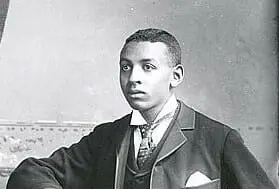
James Robinson Johnston is a Dalhousie University legend. The argument could be made for him as a Halifax or Nova Scotian legend too.
Johnston broke colour barrier after colour barrier throughout his short 38-year life. Two of his most significant milestones came as a Dal graduate: He was the first Black Nova Scotian to graduate from a university and the first Black graduate of Dal’s law program. A third major accomplishment is his law career: He was the first Black lawyer to practice in Nova Scotia. Johnston was also an established community leader, notably as an advocate against the province’s segregated school laws at the time.
But one of Johnston’s less recognized accomplishments was his work in hockey, particularly for the Coloured Hockey League of the Maritimes (CHL). With the league being groundbreaking in both revolutionizing how hockey is played and as the first notable majority/all-Black hockey league, perhaps it’s time to consider him for legendary status in the sport too.
Accounts of the CHL’s origins and history have been gathered by brothers George and Darril Fosty in their book Black Ice: The Lost History of the Coloured Hockey League of the Maritimes. These accounts credit the local Baptist church, of which Johnston was an active member, as a driver behind the beginnings of the CHL.
Church and player recruitment
The idea behind the CHL was to help recruit Black people to the Baptist church and then play hockey against other church teams after services. The CHL’s founders were Black Baptist leaders in the community at the time, including Johnston (who still attended Dal at the time), Pastor James Borden, James A.R. Kinney and Henry Sylvester Williams. Johnston, along with his work on the recruiting side as a Baptist church member, was a league organizer and an official for league games.
The CHL began in 1895, 20 years after the first organized hockey game in Montreal. Within five years, the league began attracting scores of players and fans, with reports of more than a dozen teams in the CHL and games attracting more than 1,000 spectators . These attendance numbers surpassed those of many white leagues.
The CHL’s popularity and innovative nature have been tied to its close affiliation with the Baptist church: According to the Canadian Encyclopedia website, CHL games were played “with no official rules other than the Bible.” With that, the league was much more physical and less strict on rules than other leagues, which allowed for play to flow with quickness.
Hockey firsts in the CHL
Until the last couple of decades, the CHL hasn’t been getting its due respect. Not only is it the first league in hockey history with such immense participation of Black players, but it should also be commended for the rules and playing styles that are said to have originated in the league.
For instance, early hockey rules were tough on goalies: A lot of leagues required they stay in their net and on their feet. The CHL, historians agree, was the first league to allow more of a rogue goaltending style, where goalies could do whatever it takes to stop the puck and even join into the play like passing to teammates. In their book, based on articles and accounts written when the league was active, the Fosty brothers claim the slap shot was invented by Eddie Martin, a CHL player, in 1906.
Johnston himself never played or invented a move that revolutionized the game, but maintained his full support with the CHL in its early history. A railway expansion dispute in the first decade of the 20th century, put the Black community in a tense relationship with the city of Halifax. This new railway proposal entailed bulldozing through Africville, and destroying the community and homes where many CHL players lived. Johnston represented many Africville residents, including players, in court to try and stop the railway annexation.
At the same time many rink owners in Halifax, who were in favour of the railway, stopped renting ice to Black players. Without proper facilities, local ponds became the only location for games and contributed to lost interest in the sport. The railway dispute led to the end of the league, although the CHL enjoyed a brief comeback in the 1920s.
A legacy due for recognition
The CHL’s history, especially its first 15-year run, was a roller-coaster. Its playing style was revolutionary and was possibly the origin of how quick and physical the sport is today, but it also opened the door for Black hockey players to play more, especially in the Maritimes. In fact, Willie O’Ree, the first Black National Hockey League (NHL) player, is from Fredericton, further highlighting hockey’s growth in diversity in the region.
Nova Scotia is mentioned plenty in hockey history, ranging from being the possible birthplace of hockey (an early version was played in Windsor, Ont., years before the first game, and the Mi’kmaq are recognized as inventing the ice hockey stick) to being the home of present-day NHL stars like Sidney Crosby and Nathan MacKinnon. But seldom do we hear talk about the CHL. Considering what the league brought to the sport, you don’t see it or any of its builders in the Hockey Hall of Fame like other parts of early hockey history. Last year, however, Canada Post released a postage stamp featuring CHL players to celebrate the history of Black Canadian hockey players.
The league itself was popular and paved the way for many more players, Black players in particular. It’s time for the CHL to be recognized more in hockey’s origins and in places like the Hall of Fame. Johnston, being so important behind the league’s success, paved his way as a builder of the beloved Canadian sport.


Recent Comments